How to Make a DIY Non-Toxic Oven Cleaner
We all know that keeping our kitchen appliances spick and span can be quite the chore. Unfortunately, many store-bought commercial oven cleaners are loaded with harmful chemicals that aren’t exactly kind to the environment or your health. However, the good news is that it’s incredibly easy to make your own non-toxic oven cleaner!
This super easy and effective recipe for an all-natural, non-toxic oven cleaner will leave your oven gleaming and your conscience clear. Not only will you be reducing your carbon footprint, but you’ll also create a healthier living space for you and your loved ones.
So, gather your ingredients, and let’s embark on a journey to a cleaner, greener kitchen. Whether you’re a seasoned eco-warrior or just starting to dip your toes into sustainable living, this DIY non-toxic oven cleaner is a fantastic addition to your green cleaning arsenal.
The Problem With Conventional Oven Cleaners
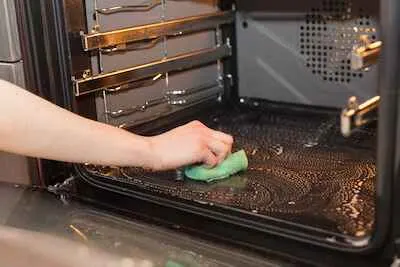
A lot of store-bought chemical oven cleaners advertise themselves as a quick and easy way to get a sparkling clean oven without a lot of effort. Unfortunately, what they don’t tell you is the harm you’re causing to your health and the health of your family in the process.
Consider a popular cleaner like EASY-OFF Heavy Duty Oven Cleaner. The Environmental Working Group (EWG) gives this cleaner an “F” grade, which is the lowest grade possible.
The reason for this failing grade is because of all the harsh chemicals it contains. Here are just a few of the most concerning offenders:
- Sodium Hydroxide: Concerns about skin irritation, damage to vision, and respiratory effects.
- Ethanolamine: Concerns about skin irritation, general organ damage, chronic aquatic toxicity, damage to vision, nervous system effects, respiratory effects, and developmental/reproductive effects.
- Butoxydiglycol: Concerns about respiratory effects, damage to vision, digestive system effects, developmental/reproductive effects, and cancer.
- Petroleum Gases: Concerns about damage to DNA, developmental/reproductive effects, and cancer.
And these are just some of the worst ingredients. The cleaner also contains fragrance, which is a non-specific ingredient. Companies can use this ingredient to hide hundreds of other chemicals that have unknown effects on our health and the environment.
The Step-by-Step Guide on How to Make a Natural Oven Cleaner
Now that you know why it’s so important to stop using those toxic commercial cleaners and make the switch to an eco-friendly oven cleaner, you’re probably ready to get started. Whether you have an electric oven or a gas oven, here’s how to make the best oven cleaner using natural ingredients that can tackle even the toughest messes and leave your dirty oven sparkling clean.
Step 1: Gather the Ingredients
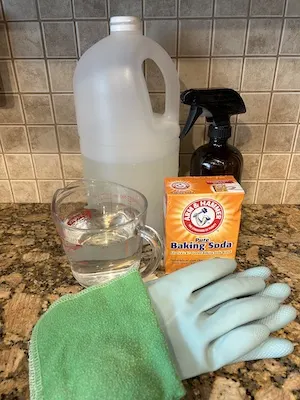
To get the inside of your oven shiny and clean, you’ll need to start by gathering the following ingredients and materials:
Step 2: Take Out the Oven Rakes
Take out the oven rakes so it’s easier to get to the bottom of your oven. To ensure you don’t transfer any grime from the racks to your floors or countertops, consider placing them on old towels or newspapers.
Take this time to also remove anything else that might be in your oven, such as pans, a cookie sheet, or a thermometer.
Step 3: Make the Homemade Oven Cleaner
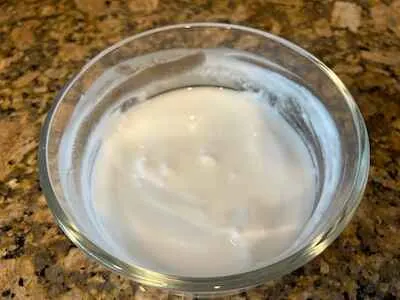
To make your non-toxic oven cleaner, mix together equal parts of baking soda and water until they form a spreadable paste. I like to start with half a cup of both ingredients and then make more as needed.
Related: Get Your Dishes Naturally Clean With the Best Eco-Friendly Dish Soap
You’ll be coating the entire inside of your oven with this cleaning paste, so be sure you make enough to cover the whole oven.
Step 4: Apply the Cleaning Paste
Once you’ve made the baking soda paste, spread it around the interior of the oven.
This can be a pretty messy process. If you don’t want paste and grime under your fingernails, or your skin is sensitive to baking soda, I recommend wearing a pair of rubber gloves.
As you’re spreading the paste, be sure to keep it off the heating elements. For added cleaning power, you can apply a thicker amount of paste in extra dirty spots, such as the bottom of the oven.
Step 5: Clean the Other Areas While You Wait
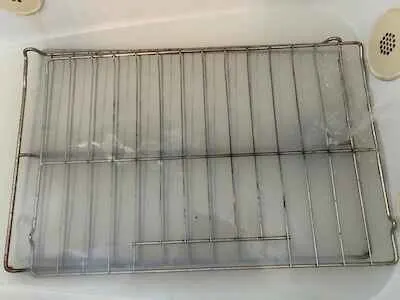
To work properly, this oven cleaner needs to sit for at least 12 hours. I find you’ll get the best results if you let it sit overnight.
While you’re waiting, you can clean the other parts of the oven. The easiest way to clean oven racks is to soak them in a mixture of hot water and 1/4 cup of unscented Dr. Bronner’s Castile soap for a few hours.
Related: Genius Ways You Can Use Castile Soap Around Your Entire House
Since oven racks tend to be too big and bulky to fit in the sink, I find it best to soak them in the bathtub. Don’t forget to place some old towels on the bottom of the tub to keep dirt or grime from transferring.
You can also use this time to clean the stovetop and wipe down the knobs on the outside of the oven.
Step 6: Wipe Away the Cleaning Paste
Once you’ve let the oven cleaner sit long enough, use a damp cloth to wipe away the paste from the oven interior. If some elbow grease isn’t enough to clear away baked-on grease, burnt-on dirt, tough stains, or any other stubborn areas, consider using an old toothbrush.
Related: How to Reduce Your Paper Towel Use in Just 5 Simple Steps
Loosen the residue gently so you don’t accidentally scratch the surface. Avoid using a scouring pad since it can damage the oven surface.
Step 7: Spray Vinegar Inside the Oven
Pour some white cleaning vinegar into a spray bottle and spritz it all over the inside of the oven. White vinegar is an outstanding natural cleaner that you can use in a variety of surprising ways around the house.
Related: 8 Things You Should Never Clean With Vinegar
It will cause any residual baking soda paste to foam up. This will help loosen grime on those tough spots and make it easier to wipe away the last of the paste.
Step 8: Clean the Oven Glass
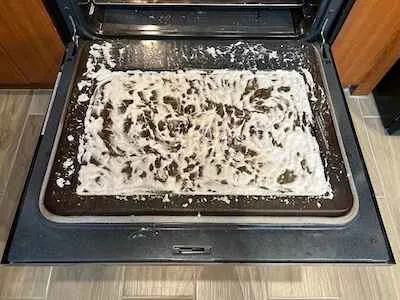
The final step to naturally cleaning the oven is to clean the glass door. After all, you don’t want it to look like you never cleaned your oven simply because the door is dirty!
To clean the glass oven door, make another batch of baking soda paste and spread it all over the inside of the window. Let it sit for about 30 minutes, and then wipe it off with a damp rag.
You can then use a glass cleaner to wipe down the outside of the glass door and the exterior of the oven for a spotless shine that doesn’t release any heavy fumes!
Homemade Non-Toxic Oven Cleaner Results
A homemade cleaner is only a good option if it’s actually effective. So let’s take a look at the results. Here’s a picture of our oven before I cleaned it. As you can see, it’s looking pretty bad.
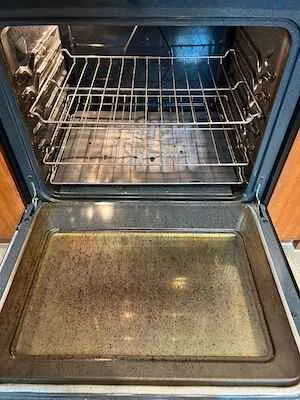
And here’s how our oven looks after I used this non-toxic oven cleaner.
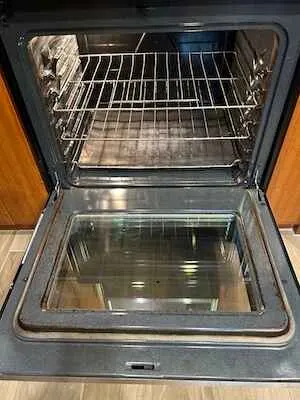
What a huge difference! You can actually see through the glass door now. Best of all, I don’t have worry about any toxic fumes and I didn’t have to do any hard scrubbing!
Additional Easy-to-Make Natural Cleaning Products
If you’re ready to ditch all of the those toxic cleaning products and make your home a safer and greener place, you’re in luck! This homemade non-toxic oven cleaner isn’t the only natural cleaning product you can make.
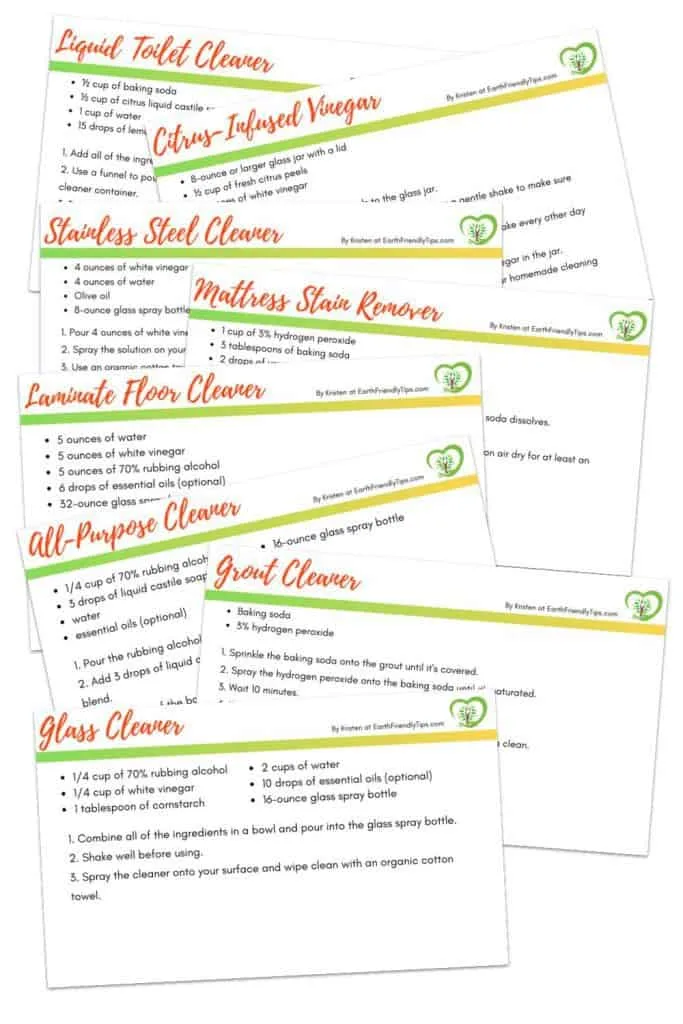
From dishwasher tablets to an all-purpose cleaner, this bundle includes 25 printable recipe cards and labels for DIY cleaning products you can use to naturally clean every part of your house. It also includes a cheat sheet on natural cleaning ingredients you never want to mix together and a guide on my favorite essential oils to combine for cleaning.
Thanks to these printable recipes, you’ll have everything you need to get your house naturally clean without the hassle of trying to remember how to make your favorite cleaning products and without the headaches caused by toxic fumes from conventional cleaning products!
Should I Use the Self-Cleaning Oven Feature?
An oven’s self-cleaning mode might sound like an even easier way to clean than a non-toxic oven cleaning paste, but there are a lot of things to keep in mind before using it.
The self-cleaning cycle works by cranking up the interior temperature to over 800°F. This high heat is supposed to burn away baked-on food particles and other grime. After the oven cools, you then need to scrape the oven walls clean.
Obviously, those high temperatures are very dangerous, so the oven should lock itself during self-cleaning mode. However, there are still several issues to consider with the self-clean feature.
First, anything the heat is burning off could create nasty odors or smoke. Additionally, grease or food particles could ignite and cause a fire risk.
Finally, it takes A LOT of power to run the self-clean feature. This feature can take anywhere from one to three hours to complete. In the meantime, it’s using a ton of energy and pumping extra heat into your home.
If it’s summertime and you’re trying to keep your house cool and comfortable without using air conditioning, using the self-cleaning function on your oven is the last thing you want to do!
Getting a Natural Clean With the Best Non-Toxic Oven Cleaner
As you wrap up your cleaning session, take a moment to appreciate the satisfaction of knowing you’ve taken another step toward a more sustainable and healthier home.
By making your own non-toxic cleaner, you’ve not only spared your oven from harsh chemicals but also contributed to a cleaner planet. It’s a small change, but every drop in the ocean counts.
Remember, sustainable living is all about taking gradual steps that align with your values and lifestyle. Making your own non-toxic cleaning products is just one of those steps, and I’m thrilled you decided to take it with me.
More Helpful Tips on Eco-Friendly Living
Did you enjoy learning more about how to make a homemade non-toxic oven cleaner that can effectively clean the inside of an oven with simple and natural ingredients? Are you interested in checking out additional tips that can help you live a more sustainable life? Then please be sure to take a look at some of our other popular posts:
- Eco-Friendly and Non-Toxic Frying Pans for Safer and Healthier Meals
- Is Dawn Dish Soap Toxic and Bad for the Environment?
- Fight Food Waste With the Electric Countertop Kitchen Composters
- Are Your Tea Bags Made With Plastic? The Scary Truth!
.jpg)
.jpg)
.jpg)